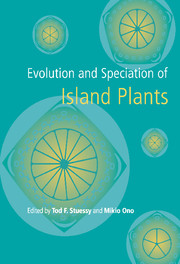Book contents
- Frontmatter
- Contents
- List of contributors
- Preface
- Acknowledgements
- Part one Hawaiian Islands
- Part two Juan Fernandez Islands
- Introduction
- 3 Isolating mechanisms and modes of speciation in endemic angiosperms of the Juan Fernandez Islands
- 4 Dendroseris (Asteraceae: Lactuceae) and Robinsonia (Asteraceae: Senecioneae) on the Juan Fernandez Islands: similarities and differences in biology and phylogeny
- 5 Island biogeography of angiosperms of the Juan Fernandez archipelago
- Part three Southern and western Pacific Islands
- Part four General evolutionary patterns and processes on oceanic islands
- Author index
- Taxon index
- Subject index
5 - Island biogeography of angiosperms of the Juan Fernandez archipelago
Published online by Cambridge University Press: 04 May 2010
- Frontmatter
- Contents
- List of contributors
- Preface
- Acknowledgements
- Part one Hawaiian Islands
- Part two Juan Fernandez Islands
- Introduction
- 3 Isolating mechanisms and modes of speciation in endemic angiosperms of the Juan Fernandez Islands
- 4 Dendroseris (Asteraceae: Lactuceae) and Robinsonia (Asteraceae: Senecioneae) on the Juan Fernandez Islands: similarities and differences in biology and phylogeny
- 5 Island biogeography of angiosperms of the Juan Fernandez archipelago
- Part three Southern and western Pacific Islands
- Part four General evolutionary patterns and processes on oceanic islands
- Author index
- Taxon index
- Subject index
Summary
Abstract
MacArthur & Wilson's (1967) equilibrium theory of island biogeography predicts that numbers of species on oceanic islands are dependent upon the size of islands, distance from major source area, and rates of immigration and extinction. Despite healthy criticisms of this theory, it has been enormously stimulating for understanding species diversity on islands as well as other island-like habitats. More recently, other workers have attempted more complex models to find better ways of predicting species diversity in oceanic archipelagoes. The Juan Fernandez Islands are well suited for specific model assessment due to the small size of the endemic and native flora (156 angiosperm species), the few major islands (Masatierra and Masafuera), their small size (50 km2 each) and proximity to the major source area (southern South America). Factors taken into consideration include size (both ancient and modern), distance from source area, extinction, speciation within and between islands, and differing modes of dispersal. A model for predicting species diversity is first developed to explain numbers of species on Masatierra, the island closest to the continent (667 km in the Pacific Ocean). This approach is then applied to explain species diversity on Masafuera, with encouraging results. The most important point is that numerous geological, ecological and historical factors impinge on determining the total number of species that can be supported on a particular oceanic island. Changing island size through geological time is especially important to consider.
- Type
- Chapter
- Information
- Evolution and Speciation of Island Plants , pp. 121 - 138Publisher: Cambridge University PressPrint publication year: 1998
- 17
- Cited by



